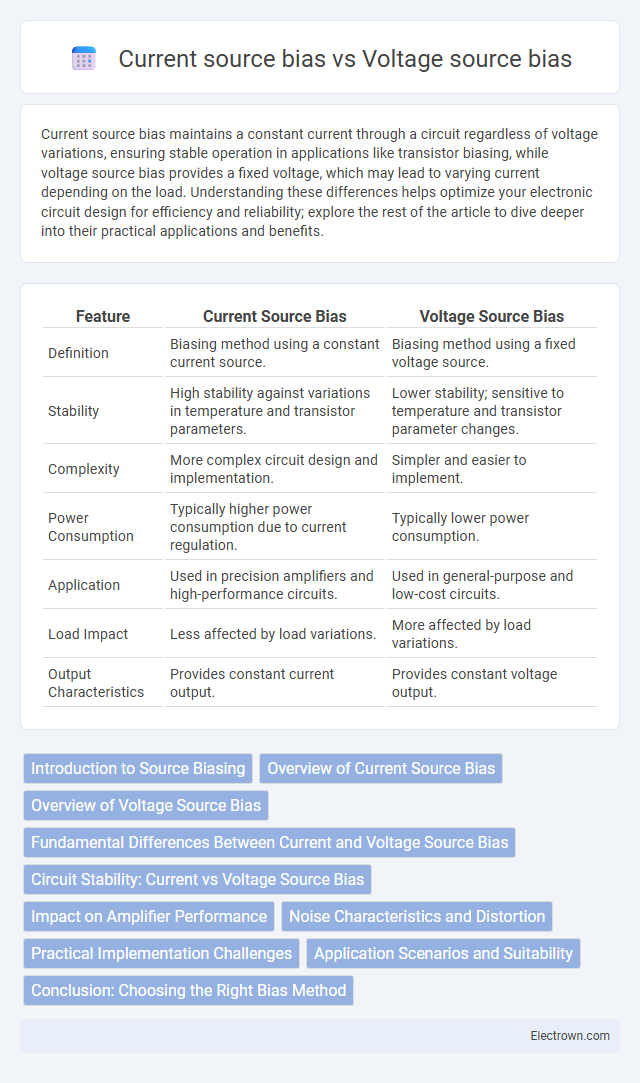Current source bias maintains a constant current through a circuit regardless of voltage variations, ensuring stable operation in applications like transistor biasing, while voltage source bias provides a fixed voltage, which may lead to varying current depending on the load. Understanding these differences helps optimize your electronic circuit design for efficiency and reliability; explore the rest of the article to dive deeper into their practical applications and benefits.
Table of Comparison
| Feature | Current Source Bias | Voltage Source Bias |
|---|---|---|
| Definition | Biasing method using a constant current source. | Biasing method using a fixed voltage source. |
| Stability | High stability against variations in temperature and transistor parameters. | Lower stability; sensitive to temperature and transistor parameter changes. |
| Complexity | More complex circuit design and implementation. | Simpler and easier to implement. |
| Power Consumption | Typically higher power consumption due to current regulation. | Typically lower power consumption. |
| Application | Used in precision amplifiers and high-performance circuits. | Used in general-purpose and low-cost circuits. |
| Load Impact | Less affected by load variations. | More affected by load variations. |
| Output Characteristics | Provides constant current output. | Provides constant voltage output. |
Introduction to Source Biasing
Source biasing techniques in electronic circuits primarily involve current source bias and voltage source bias, each serving distinct purposes for transistor operation. Current source bias provides a stable and constant current regardless of voltage variations, enhancing linearity and reducing distortion in amplifiers. Voltage source bias, on the other hand, maintains a fixed voltage to set the operating point but is more susceptible to changes in transistor parameters and temperature.
Overview of Current Source Bias
Current source bias maintains a constant current through a transistor regardless of voltage variations, enabling stable operating points and improved gain stability in amplifier circuits. It offers high output impedance and better linearity compared to voltage source bias, which relies on a fixed voltage supply that may vary with load changes. This biasing method is widely used in analog design for enhancing signal integrity and reducing distortion.
Overview of Voltage Source Bias
Voltage source bias provides a stable and constant voltage output regardless of the load current, ensuring predictable circuit behavior. It is commonly used in analog circuits to maintain fixed operating points in transistors and amplifiers. This biasing technique simplifies design by controlling voltage levels, but may require additional components to regulate current variation effectively.
Fundamental Differences Between Current and Voltage Source Bias
Current source bias provides a constant current regardless of voltage changes across the device, ensuring stable operating conditions for transistors in analog circuits. Voltage source bias maintains a fixed voltage, allowing current to vary with the device's resistance, which suits applications requiring precise voltage control. Understanding these fundamental differences helps you select the appropriate biasing method for optimizing transistor performance in specific electronic designs.
Circuit Stability: Current vs Voltage Source Bias
Current source bias provides superior circuit stability by maintaining a constant current regardless of voltage fluctuations, which helps prevent variations in transistor operation and enhances overall device performance. Voltage source bias, while simpler, is more susceptible to changes in load and temperature, causing instability in current flow and potentially impacting circuit reliability. Your choice of a current source bias is critical for applications requiring precise and stable operating conditions, particularly in analog and RF circuits.
Impact on Amplifier Performance
Current source bias improves amplifier linearity and thermal stability by providing constant current regardless of voltage variations, enhancing gain accuracy and reducing distortion. Voltage source bias, while simpler, can lead to signal-dependent current fluctuations that increase distortion and limit frequency response. Using current source bias results in better overall amplifier efficiency and noise performance, critical in high-precision analog circuits.
Noise Characteristics and Distortion
Current source bias offers lower noise characteristics due to its constant current flow, minimizing thermal noise and enhancing signal integrity in sensitive analog circuits. Voltage source bias can introduce higher distortion levels as voltage fluctuations cause non-linear device behavior, impacting overall linearity and signal accuracy. In precision applications, current source bias is preferred for maintaining low distortion and superior noise performance.
Practical Implementation Challenges
Current source bias offers stable current flow despite voltage variations, but implementing it demands high-precision components and careful thermal management to avoid instability. Voltage source bias is simpler to implement with basic resistor networks but suffers from variability due to load changes and power supply fluctuations. Your choice affects circuit reliability and complexity, balancing precision needs with practical constraints.
Application Scenarios and Suitability
Current source bias is ideal for applications requiring stable current regardless of load variations, such as in LED drivers and transistor amplifier circuits, ensuring consistent performance. Voltage source bias suits scenarios where maintaining a constant voltage is essential, like in digital logic circuits and sensor interfaces, providing reliable signal references. Your choice depends on whether current stability or voltage consistency better meets the needs of your specific electronic design.
Conclusion: Choosing the Right Bias Method
Current source bias offers improved stability and thermal compensation, making it ideal for circuits requiring consistent operating points regardless of transistor parameter variations. Voltage source bias provides simplicity and ease of implementation but is more susceptible to variations caused by temperature changes and transistor beta differences. Selecting the appropriate bias method depends on the application's need for precision, stability, and design complexity.
Current source bias vs voltage source bias Infographic

 electrown.com
electrown.com